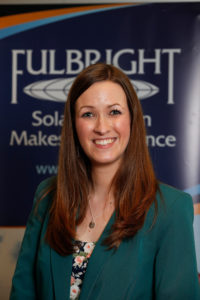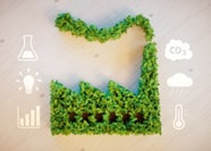Laura Devaney
 “Not content with addressing just one of the Sustainable Development Goals (SDGs), I would like to propose a concept that has the potential to address at least nine of them and has formed a central research interest of mine as an environmental geographer. Couched within the quest for a more sustainable future, the bioeconomy represents an alternative economic system to the fossil fuel based economy on which we have come to rely; the very system that caused unprecedented levels of pollution, greenhouse gas emissions and environmental degradation that led to a need for the Sustainable Development Goals to be established in the first place. A vicious cycle. But how about creating a cleaner, greener, more efficient and biobased cycle to address, and perhaps even reverse, these concerns?
“Not content with addressing just one of the Sustainable Development Goals (SDGs), I would like to propose a concept that has the potential to address at least nine of them and has formed a central research interest of mine as an environmental geographer. Couched within the quest for a more sustainable future, the bioeconomy represents an alternative economic system to the fossil fuel based economy on which we have come to rely; the very system that caused unprecedented levels of pollution, greenhouse gas emissions and environmental degradation that led to a need for the Sustainable Development Goals to be established in the first place. A vicious cycle. But how about creating a cleaner, greener, more efficient and biobased cycle to address, and perhaps even reverse, these concerns?With potential to reduce waste, mitigate climate change, develop food and energy security, address resource scarcity, cut emissions and minimise pollution, the bioeconomy involves the creation of an economic system where fossil fuels are replaced by renewable biological resources and biomass is processed and transformed to meet everyday needs for food, feed, fuel and fibre (Staffas et al., 2013; Bugge et al., 2016; El-Chichakli et al., 2016; Devaney and Henchion, 2016; Devaney et al., 2017). It combines the outputs of agriculture, marine and forestry resource sectors with the transformative capacity of food, biochemical, biomaterial and bioenergy industries. As a “still-evolving” concept (Bracco et al., 2018), the bioeconomy has been translated in different ways internationally with varying emphasis on its biotechnological, bioresource and bioecology aspects (Bugge et al, 2016). Such alternate visions reflect not only the different motives behind bioeconomy development but the range of opportunities it presents to address global sustainability challenges. The bioeconomy thus continues to gain traction across policy, industry and academic spheres.
Sounds too good to be true? Well of course, the caveat is that the bioeconomy MUST be developed in an environmentally and socially sustainable way so that it does not become self-defeating in its sustainability aims. It must not replicate the extractive, destructive nature of the fossil-based economy that came before it. This requires careful consideration and management of both production and consumption dimensions such that biological resources are produced in an environmentally sound manner and that we simply are not just producing more unnecessary ‘stuff’’ for heedless consumption; biobased or otherwise. Having recently returned from a research visit to the US, I have also become increasingly conscious of issues of environmental justice associated with the bioeconomy so that its benefits truly filter to all parts of society. After all, if executed ‘correctly’, the bioeconomy holds promise to reduce rural-urban divides and revitalise marginalised communities to supply the biomass that forms the very foundation of global bioeconomies. From a consumption perspective, uncomfortable conversations (for some) are required on the need for de-growth alongside bioeconomy developments to fundamentally shift our consumption patterns, practices and behaviours.
must not replicate the extractive, destructive nature of the fossil-based economy that came before it. This requires careful consideration and management of both production and consumption dimensions such that biological resources are produced in an environmentally sound manner and that we simply are not just producing more unnecessary ‘stuff’’ for heedless consumption; biobased or otherwise. Having recently returned from a research visit to the US, I have also become increasingly conscious of issues of environmental justice associated with the bioeconomy so that its benefits truly filter to all parts of society. After all, if executed ‘correctly’, the bioeconomy holds promise to reduce rural-urban divides and revitalise marginalised communities to supply the biomass that forms the very foundation of global bioeconomies. From a consumption perspective, uncomfortable conversations (for some) are required on the need for de-growth alongside bioeconomy developments to fundamentally shift our consumption patterns, practices and behaviours.
Combining these caveats and concerns, there is a need and indeed desires (as experienced in the US context), for the creation of regenerative and socially just bioeconomies worldwide that not only reduce environmental ‘bad’ but also create environmental ‘good’ (e.g. through carbon sequestration) and are enacted in a socially sound and inclusive manner (Devaney and Iles, 2018). Such an ideal sustainable future will require a robust governance system to guide it, one that ensures that all voices are heard, marginalised actors are included and environmental checks and balances are in place to truly achieve sustained, inclusive and sustainable economic growth (in keeping with the eight SDG). This is a fundamental research interest of mine, and as a geographer, with particular consideration as to how these governing relationships are, and should be, formed, organised and perform across scales from local to global. How and where stakeholders are embedded and invest in the bioeconomy is important to develop shared bioeconomy visions and commonly agreed bioeconomy principles to guide this economic transition. Considering ‘good’ governance in the bioeconomy has been a cornerstone of my work and policy influence, developing frameworks and conditions for sustainable bioeconomy development that have subsequently guided both national and international bioeconomy policy development (for example, the Irish Government’s National Policy Statement on the Bioeconomy (Department of the Taoiseach, 2018) and the German Bioeconomy Council’s analysis of bioeconomy trends and progress worldwide (GBC, 2018)).
This preoccupation has led me to conduct geographical research across Ireland, Europe, Canada and the US, assessing the development and governance of diverse global bioeconomies and the stakeholder influences, supports and hindrances present across scales. After all, bioeconomy development must be geographically tailored to reflect different resource bases, industrial capacities, markets, governing regimes, histories, priorities and agendas at national and local scales. There is also potential for developing regional bioeconomy clusters to provide support and cohesion to the biobased transition nationally and internationally (Devaney and Iles, 2018).
Enacted in this way, the bioeconomy can begin to address multiple SDGs including:
- Goal 2 – End hunger, achieve food security and improved nutrition, and promote sustainable agriculture
- Goal 7 – Ensure access to affordable, reliable, sustainable and modern energy for all.
- Goal 8 – Promote sustained, inclusive and sustainable economic growth, full and productive employment and decent work for all
- Goal 9 – Build resilient infrastructure, promote inclusive and sustainable industrialisation, and foster innovation
- Goal 10 – Reduce income inequality within and among countries
- Goal 12 – Ensure sustainable consumption and production patterns
- Goal 13 – Take urgent action to combat climate change and its impacts
- Goal 14 – Conserve and sustainably use the oceans, seas and marine resources for sustainable development
- Goal 15 – Protect, restore and promote sustainable use of terrestrial ecosystems, sustainably manage forests, combat desertification, and halt and reverse land degradation and halt biodiversity loss
Connecting the development of the bioeconomy with the achievement of the SDGs is essential and appropriate at local, national, regional and global scales. The concepts should not be seen as mutually exclusive or in isolation of one another (for example, when developing bioeconomy strategies and SDG implementation plans). The two can go hand-in-hand and indeed act as essential measures of progress for one another. Further research interests include the development of diverse global bioeconomies along these lines and investigating how these contributions can be made in practice. I look forward to continuing my work in this area, grounded in my geographical understanding that while we can kill many SDG birds with one stone, one size certainly does not fit all in this promising arena.”
For References contact info@geographicalsocietyireland.ie
